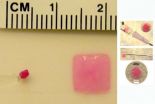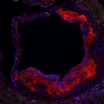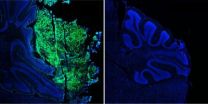(Press-News.org) From monsters under the bed to bogeymen in the closet, most children experience nighttime fears at some point in their development. And while most grow out of them without any professional intervention, others contend with persistent and extended periods of these fears, with a risk of developing anxiety problems later in life.
As part of a large-scale project on nighttime fears funded by the Israeli Science Foundation, Prof. Avi Sadeh of Tel Aviv University's School of Psychological Sciences is exploring how these fears fit into the normal developmental process — and when they become a problem. Together with Dr. Jonathan Kushnir, who completed his Ph.D. studies in the field in Prof. Sadeh's lab, MA student Tamar Zisenwine, and Ph.D. student Michal Kaplan, he discovered that a child's ability to differentiate fact from fiction has a huge impact on overcoming terror of things that go bump in the night.
In their study, published in Child Psychiatry and Human Development, the researchers found that preschoolers with persistent nighttime fears were far less able to distinguish reality from fantasy compared to their peers. The research will help clinicians and parents alike to develop interventions that can better soothe fretful children, he says, noting that a strong imagination can ultimately be used to the child's psychological advantage.
Separating fact and fiction
For young children undergoing significant development in their ability to differentiate reality from fantasy, bedtime can be a major challenge. In many cases, it is the only time of the day when they're left to face their thoughts, feelings, and fears alone, explains Prof. Sadeh. This is when imagination can run wild.
To test their hypothesis that fantasy–reality confusion has a strong impact on nighttime fears, researchers evaluated four-to-six-year-old children — 80 of them diagnosed with severe nighttime fears and 32 with more normal development — on their ability to separate fact from fiction based on parental reports and a standardized interview. For example, children were presented with the character of a fairy, then asked a series of questions to determine whether or not the fairy was fictional, including whether or not they could call the fairy by phone or the fairy could visit them at home.
Children with more intense nighttime fears were significantly less able to differentiate reality from fantasy. As expected, younger children of the group also scored lower on these evaluations than their elders, a result attributable to the children's developmental stage. The lower the score, the more severe the child's nighttime fears.
The power of imagination
According to Prof. Sadeh, the fantasy-reality confusion that causes nighttime fears can also be used to help children to overcome these fears. Parents and clinicians can use this affinity for the imaginary to the child's benefit.
"We send children mixed signals by telling them that monsters aren't real while we tell them stories about the tooth fairy," he explains. Simply telling a child that their fear isn't realistic doesn't solve the problem, he says. Prof. Sadeh recommends using the child's strong imagination as a treatment. For instance, parents might help their children view an imaginary monster as a non-threatening entity, perhaps by writing it a letter to extend an offer of friendship or reading the child a book in which a threatening figure turns out to be friendly.
One treatment that Prof. Sadeh has found highly effective is a toy called a "huggy puppy." In this therapy, children are presented with a stuffed dog and told that the once happy puppy is now sad. They are given the responsibility of being the puppy's friend, caring for him, and ensuring that he is not afraid at night. Because this intervention depends on the child's willingness to believe the huggy puppy's story and embrace their new compassionate role, it works best for children with stronger imaginations, he says.
INFORMATION:
American Friends of Tel Aviv University (www.aftau.org) supports Israel's leading, most comprehensive and most sought-after center of higher learning. Independently ranked 94th among the world's top universities for the impact of its research, TAU's innovations and discoveries are cited more often by the global scientific community than all but 10 other universities.
Internationally recognized for the scope and groundbreaking nature of its research and scholarship, Tel Aviv University consistently produces work with profound implications for the future.
Fantasy-reality confusion a primary cause of childhood nighttime fears
Therapies based on imagination could prove an effective cure, says a Tel Aviv University researcher
2012-11-14
ELSE PRESS RELEASES FROM THIS DATE:
Injectable sponge delivers drugs, cells, and structure
2012-11-14
Cambridge, Mass. – November 13, 2012 – Bioengineers at Harvard have developed a gel-based sponge that can be molded to any shape, loaded with drugs or stem cells, compressed to a fraction of its size, and delivered via injection. Once inside the body, it pops back to its original shape and gradually releases its cargo, before safely degrading.
The biocompatible technology, revealed this week in the Proceedings of the National Academy of Sciences, amounts to a prefabricated healing kit for a range of minimally invasive therapeutic applications, including regenerative medicine.
"What ...
Targeting downstream proteins in cancer-causing pathway shows promise in cell, animal model
2012-11-14
PHILADELPHIA - The cancer-causing form of the gene Myc alters the metabolism of mitochondria, the cell's powerhouse, making it dependent on the amino acid glutamine for survival. In fact, 40 percent of all "hard-to-treat" cancers have a mutation in the Myc gene.
Accordingly, depriving cells of glutamine selectively induces programmed cell death in cells overexpressing mutant Myc.
Using Myc-active neuroblastoma cancer cells, a team led by Howard Hughes Medical Institute (HHMI) investigator M. Celeste Simon, Ph.D., scientific director for the Abramson Family Cancer ...
Vitamin D may prevent clogged arteries in diabetics
2012-11-14
People with diabetes often develop clogged arteries that cause heart disease, and new research at Washington University School of Medicine in St. Louis suggests that low vitamin D levels are to blame.
In a study published Nov. 9 in the Journal of Biological Chemistry, the researchers report that blood vessels are less like to clog in people with diabetes who get adequate vitamin D. But in patients with insufficient vitamin D, immune cells bind to blood vessels near the heart, then trap cholesterol to block those blood vessels.
"About 26 million Americans now have type ...
Being neurotic, and conscientious, a good combo for health
2012-11-14
Under certain circumstances neuroticism can be good for your health, according to a University of Rochester Medical Center study showing that some self-described neurotics also tended to have the lowest levels of Interleukin 6 (IL-6), a biomarker for inflammation and chronic disease.
Researchers made the preliminary discovery while conducting research into how psychosocial factors such as personality traits influence underlying biology, to predict harmful conditions like inflammation.
Known as one of the "Big 5" traits, neuroticism is usually marked by being moody, nervous, ...
Research strengthens link between obesity and dental health in homeless children
2012-11-14
Obesity and dental cavities increase and become epidemic as children living below the poverty level age, according to nurse researchers from the Case Western Reserve University and the University of Akron.
"It's the leading cause of chronic infections in children," said Marguerite DiMarco, associate professor at the Frances Payne Bolton School of Nursing at Case Western Reserve University.
Researchers Sheau-Huey Chiu, assistant professor, and graduate assistant Jessica L. Prokp, from the University of Akron's College of Nursing, contributed to the study.
Researchers ...
For brain tumors, origins matter
2012-11-14
Cancers arise when a normal cell acquires a mutation in a gene that regulates cellular growth or survival. But the particular cell this mutation happens in—the cell of origin—can have an enormous impact on the behavior of the tumor, and on the strategies used to treat it.
Robert Wechsler-Reya, Ph.D., professor and program director at Sanford-Burnham Medical Research Institute, and his team study medulloblastoma, the most common malignant brain cancer in children. A few years ago, they made an important discovery: medulloblastoma can originate from one of two cell types: ...
Stem cell finding could advance immunotherapy for lung cancer
2012-11-14
CINCINNATI—A University of Cincinnati (UC) Cancer Institute lung cancer research team reports that lung cancer stem cells can be isolated—and then grown—in a preclinical model, offering a new avenue for investigating immunotherapy treatment options that specifically target stem cells.
John C. Morris, MD, and his colleagues report their findings in the Nov. 13, 2012, issue of PLOS One, a peer-reviewed online publication that features original research from all disciplines within science and medicine.
Stem cells are unique cells that can divide and differentiate into ...
New type of bacterial protection found within cells
2012-11-14
Irvine, Calif., Nov. 13, 2012 — UC Irvine biologists have discovered that fats within cells store a class of proteins with potent antibacterial activity, revealing a previously unknown type of immune system response that targets and kills bacterial infections.
Steven Gross, UCI professor of developmental & cell biology, and colleagues identified this novel intercellular role of histone proteins in fruit flies, and it could herald a new approach to fighting bacterial growth within cells. The study appears today in eLife, a new peer-reviewed, open-access journal supported ...
Uranium exposure linked to increased lupus rate
2012-11-14
CINCINNATI—People living near a former uranium ore processing facility in Ohio are experiencing a higher than average rate of lupus, according a new study conducted by scientists at the University of Cincinnati and Cincinnati Children's Hospital Medical Center.
Lupus is a chronic inflammatory disease that can affect the skin, joints, kidneys, lungs, nervous system and other organs of the body. The underlying causes of lupus are unknown, but it is usually more common in women of child-bearing age.
For this new study, a collaborative team of UC and Cincinnati Children's ...
Less of a shock
2012-11-14
Implantable defibrillators currently on the market apply between 600 and 900 volts to the heart, almost 10 times the voltage from an electric outlet, says Ajit H. Janardhan, MD, PhD, a cardiac electrophysiology fellow at the Washington University's School of Medicine.
After being shocked, he says, some patients get post-traumatic stress disorder. Patients may even go so far as to ask their physicians to remove the defibrillator, even though they understand that the device has saved their lives.
The huge shocks are not only unbearably painful, they damage the heart muscle ...
LAST 30 PRESS RELEASES:
COVID-19 leaves a lasting mark on the human brain
Scientists use ultrasound to soften and treat cancer tumors without damaging healthy tissue
Community swimming program for Black youth boosts skills, sense of belonging, study finds
Specific depressive symptoms in midlife linked to increased dementia risk
An ‘illuminating’ design sheds light on cholesterol
Who is more likely to get long COVID?
Study showcases resilience and rapid growth of “living rocks”
Naval Research Lab diver earns Office of Naval Research 2025 Sailor of the Year
New Mayo-led study establishes practical definition for rapidly progressive dementia
Fossil fuel industry’s “climate false solutions” reinforce its power and aggravate environmental injustice
Researchers reveal bias in a widely used measure of algorithm performance
Alcohol causes cancer. A study from IOCB Prague confirms damage to DNA and shows how cells defend against it
Hidden viruses in wastewater treatment may shape public health risks, study finds
Unlock the power of nature: how biomass can transform climate mitigation
Biochar reshapes hidden soil microbes that capture carbon dioxide in farmland
Reducing saturated fat intake shows mortality benefit, but only in high-risk individuals
Manta rays create mobile ecosystems, study finds
Study: Mixed results in using lipoic acid to treat progressive multiple sclerosis
Norbert Holtkamp appointed director of Fermi National Accelerator Laboratory
New agentic AI platform accelerates advanced optics design
Biologists discover neurons use physical signals — not electricity — to stabilize communication
Researchers discover that a hormone can access the brain by hitchhiking
University of Oklahoma researcher awarded funding to pursue AI-powered material design
Exploring how the visual system recovers following injury
Support for parents with infants at pediatric check-ups leads to better reading and math skills in elementary school
Kids’ behavioral health is a growing share of family health costs
Day & night: Cancer disrupts the brain’s natural rhythm
COVID-19 vaccination significantly reduces risk to pregnant women and baby
The role of vaccination in maternal and perinatal outcomes associated with COVID-19 in pregnancy
Mayo Clinic smartwatch system helps parents shorten and defuse children's severe tantrums early
[Press-News.org] Fantasy-reality confusion a primary cause of childhood nighttime fearsTherapies based on imagination could prove an effective cure, says a Tel Aviv University researcher




